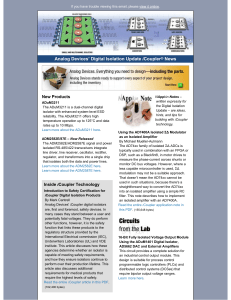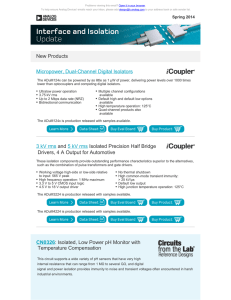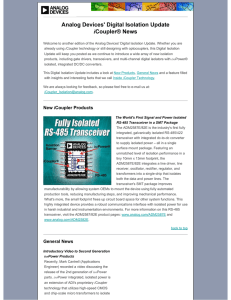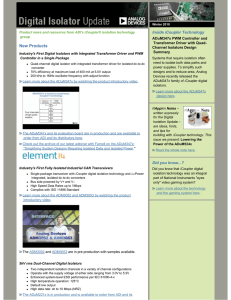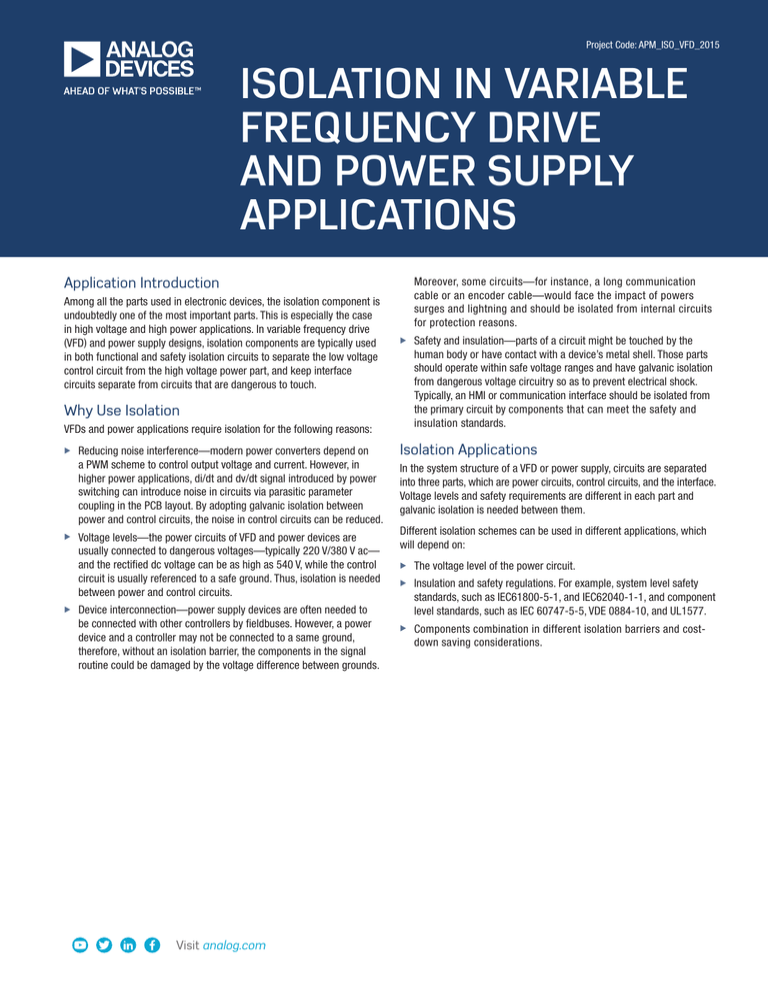
Project Code: APM_ISO_VFD_2015
ISOLATION IN VARIABLE
FREQUENCY DRIVE
AND POWER SUPPLY
APPLICATIONS
Application Introduction
Among all the parts used in electronic devices, the isolation component is
undoubtedly one of the most important parts. This is especially the case
in high voltage and high power applications. In variable frequency drive
(VFD) and power supply designs, isolation components are typically used
in both functional and safety isolation circuits to separate the low voltage
control circuit from the high voltage power part, and keep interface
circuits separate from circuits that are dangerous to touch.
Moreover, some circuits—for instance, a long communication
cable or an encoder cable—would face the impact of powers
surges and lightning and should be isolated from internal circuits
for protection reasons.
XX
Why Use Isolation
VFDs and power applications require isolation for the following reasons:
XX
XX
XX
Reducing noise interference—modern power converters depend on
a PWM scheme to control output voltage and current. However, in
higher power applications, di/dt and dv/dt signal introduced by power
switching can introduce noise in circuits via parasitic parameter
coupling in the PCB layout. By adopting galvanic isolation between
power and control circuits, the noise in control circuits can be reduced.
Voltage levels—the power circuits of VFD and power devices are
usually connected to dangerous voltages—typically 220 V/380 V ac—
and the rectified dc voltage can be as high as 540 V, while the control
circuit is usually referenced to a safe ground. Thus, isolation is needed
between power and control circuits.
Device interconnection—power supply devices are often needed to
be connected with other controllers by fieldbuses. However, a power
device and a controller may not be connected to a same ground,
therefore, without an isolation barrier, the components in the signal
routine could be damaged by the voltage difference between grounds.
Visit analog.com
Safety and insulation—parts of a circuit might be touched by the
human body or have contact with a device’s metal shell. Those parts
should operate within safe voltage ranges and have galvanic isolation
from dangerous voltage circuitry so as to prevent electrical shock.
Typically, an HMI or communication interface should be isolated from
the primary circuit by components that can meet the safety and
insulation standards.
Isolation Applications
In the system structure of a VFD or power supply, circuits are separated
into three parts, which are power circuits, control circuits, and the interface.
Voltage levels and safety requirements are different in each part and
galvanic isolation is needed between them.
Different isolation schemes can be used in different applications, which
will depend on:
XX
The voltage level of the power circuit.
XX
Insulation and safety regulations. For example, system level safety
standards, such as IEC61800-5-1, and IEC62040-1-1, and component
level standards, such as IEC 60747-5-5, VDE 0884-10, and UL1577.
XX
Components combination in different isolation barriers and costdown saving considerations.
2
Isolation in Variable Frequency Drive and Power Supply Applications
Isolated System Architecture
Live Circuit
540 V
Inverter
Vdc
U
LS
LS
AC
380 V
L-L
V
LS
AC
Motor
Sensor
W
i V, i W
312 V
Gate
Drive
θ, ω
idc
TO
ADC
Isolation
Grounded Circuit
PWM
Motor
Control
I2C
ADC
COM
Serial
Port
Feedback
Interface
Isolation
ADC
Command
Input
Network
I/F
System and
Communications
Isolated
Current
Feedback
Visit analog.com 540 V
Inverter
Vdc
U
LS
LS
AC
380 V
L-L
V
LS
AC
Motor
W
iV, iW
θ, ω
Sensor
idc
312 V
TO
Gate
Drive
Motor
Control
PWM
COM
ADC
Serial
Port
Isolated
Current
Feedback
Feedback
Interface
Live Circuit
Safety Isolation
ADC
Command
Input
Network
Drive Command
I/F
System and
Communications
Grounded Circuit
From a system point of view, minimizing the number of signal channels
requiring isolation and reducing the use of reinforced level insulation
components are important design concerns. The following architectures
are commonly used in VFD and power supply systems:
XX
Two isolation barriers design—isolation between power and control
circuits and isolation between control and interface circuits. Isolation
between power and control circuits can be achieved by using an
isolated IGBT/MOSFET gate driver, isolated current/voltage detection
components. Meanwhile, standard digital isolators, isolated ADCs, and
isolated DACs can be used to separate control and interface circuits.
This type of configuration is suitable for a VFD or power supply with
various types of interface or for higher power applications. In these
cases, signals between power and control circuits is usually fixed
including PWM signals, current/voltage feedback, and fault protection
feedback. Comparatively, there could be various types of interface
ports and may include optional accessories. For example, 0 V to 10 V,
4 mA to 20 mA analog input/output, 0 V to 24 V digital IO, relay, RS-232/
RS-485, Ethernet, USB, and CAN. Therefore, by implementing power
control isolation and control interface isolation, respectively, designers
can lower the system cost and have more freedom in component
choice since there are two isolation barriers in the system and the
requirements for each isolation layer could be lower. Additionally, the
separation of power and control can also reduce power switching
noise impact.
Interface isolation can be unnecessary if the isolation between
the power and control circuits already meets the system safety
requirements. Furthermore, double insulation can be achieved by a
combination of components in the two barriers.
XX
Power and control circuit connected to the same ground. In small
power or low voltage applications, if the number of interfaces is
limited, this type of configuration prevails. By connecting the controller
ground to the power ground, one isolation barrier can be omitted, but the
isolation requirement between the interface circuit and power part could
be higher than those in the previous configuration. Luckily, due to limited
number of interfaces, the overall system cost still can be cheaper.
ADI Isolation Technology and Products
XX
iCoupler® digital isolators transmit the information across isolation
barriers using transformers, and the primary side’s current change
causes the secondary side’s current change using the transformers.
A 20 µm of an iCoupler polyimide is rated for a working voltage of
400 V rms for 50 years and a surge rating of greater than 6 kV (10 kV
3
4
Isolation in Variable Frequency Drive and Power Supply Applications
test requirement) meeting VDE reinforced isolation requirements. The
major advantages of iCoupler technology are
• High insulation reliability under high temperature and high voltage.
iCoupler products have a 50 year lifespan operating under 400 V rms,
by using the CMOS process, and working temperatures can be as
high as 125ºC.
• Common-mode transient immunity (CMTI) up to 100 kV/μS.
More capable for motor drive, power inverter applications than
conventional optocouplers.
•
iCoupler data isolation products can meet CISPR 22 Class B (and
Replacing the isolated amplifier and ADC with an isolated Σ-Δ
modulator will eliminate the performance bottleneck and greatly
improve the design—typically taking it from a 9-bit to 10-bit quality
feedback to a 12-bit level. Analog overcurrent protection circuitry
(OCP) can also potentially be eliminated, as the digital filter required
to process the Σ-Δ modulator output can also be configured to
implement a fast OCP loop.
FCC Class B) standards.
•
iCoupler isolators can exceed 10 kv peak surge requirement for
VDE V 0884-10 Reinforced rating.
• Higher speed, better timing specifications, up to 150 Mbps data
rate, 50 ns propagation delay, good channel-to-channel match
performance, and low power consumption.
• Multiple isolation channels integrated with other functions reduce
XX
size and cost.
ADI provides a series of standard data isolation production, isolated
RS-232, RS-485, USB, CAN, SPI, I2C transceivers, amplifiers, ADCs, and
gate-driver devices.
XX
ADI provides various products for isolated current and voltage sensing.
AD740x series Σ-Δ modulators are dedicated current sensors for
VFD and power applications. Currently, there is a significant trend
for system designers to migrate from HESes to shunt resistors, with
an additional trend to move to the isolated modulator vs. an isolated
amplifier approach. Quite often, system designers replacing HESes
with shunt resistors opt for an isolated amplifier and continue using
the ADC previously used in the HES-based design. In that case, the
performance will be limited by the isolated amplifier regardless of the
analog-to-digital performance.
Isolated IGBT/MOSFET gate driver IGBT/MOSFET gate driver circuit is
critically important in VFD and power designs. Driver circuits should
possess high performance to reduce switching losses and improve
system reliability. ADI’s ADuM413x and ADuM3223/ADuM4223/
ADuM7223 have a propagation delay of merely 50 ns and CMTI up to
100 kV/μs, which makes it easier for driver circuit design.
Isolated current and voltage sensing
Detect Data
Levels
Encode Data
Levels
Transfer
Through
Transformer
Decode
Carrier
Reconstruct
Data
CMOS Top Metal
Insulation
High
Input
Low
Input
Key Product Technologies
Part Number
Description
Key Features
Benefit
Standard Digital Isolator
ADuM1100/
ADuM120x/
1-channel to 4-channel
2.5 kV rms isolation rating, −40ºC to +125ºC, reverse channels Maximum data rate 90 Mbps
ADuM130x/
standard digital isolators
ADuM140x
New generation, 3.75 kV rms isolation rating, −40ºC to +125ºC, CMTI 100 kV/μs, low propagation delay (13 ns),
4-channel standard
ADuM14x
reverse channels
digital isolator
maximum data rate 150 Mbps
Isolated Sensing
AD7403
Isolated
Σ-Δ ADC
AD7401A
Isolated
Σ-Δ ADC
5 MHz to 20 MHz external clock input rate, second-order Σ-Δ
modulator, 16-bits, no missing codes, typical offset drift vs.
temperature: 1.6 μV/°C, 88 dB SNR, 830 V rms maximum
working voltage, −40ºC to +125ºC
5 MHz to 20 MHz external clock input rate, second-order Σ-Δ
modulator, 16-bits, no missing codes, typical offset drift vs.
temperature: 1.6 μV/°C, 88 dB SNR, 630 V rms maximum
working voltage, −40ºC to +125ºC
14-bits ENOB, ±320 mV full-scale analog input range,
UL1577, CSA60950, VDE0884-10
14-bits ENOB, ±250 mV full-scale analog input range,
UL1577, CSA60950, VDE0884-10
Isolated Gate Driver
ADuM4135
Isolated IGBT gate driver
ADuM4223
Isolated MOSFET/IGBT
gate driver
50 ns propagation delay, UVLO, desat protection,
4 A peak drive output capability, 500 V rms, 1200 V dc working
soft-shutdown on fault, miller clamp output with gate
voltage, −40ºC to +125ºC
sense input, UL, CSA, VDE
4 A peak output current, high frequency operation: 1 MHz,
high-side and low-side isolation: 537 V peak and 800 V peak
High-side and low-side isolation, UL, CSA, VDE
for differential input, −40ºC to +125ºC
Visit analog.com Part Number
Description
Isolated Communication
Isolated RS-232
ADM3251E
transceiver
ADM2687E
Isolated RS-485/
RS-422 transceiver
ADuM4160
USB port isolator
ADM3054
ADuM4150
Key Features
460 kbps data rate, 2.5 kV isolation
Configurable as half or full duplex, 5 kV rms isolation rating,
500 kbps data rate, 5 V or 3.3 V operation
Isolated controller area
network (CAN)
Isolators for high-speed
SPI interface
ADuM2250
Dual I2C Isolators
ADuM4190
Isolated error amplifier
isoPower
ADuM5000/
ADuM6000
Benefit
Isolated dc-to-dc converter
Fully USB 2.0 compliant, low and full speed data rate: 1.5 Mbps
and 12 Mbps, 5 kV rms isolation rating, 3.3 V and 5 V
(dual mode power configuration) operation
complies with the ISO 11898 standard, 1 Mbps, 5 kV rms
isolation rating, 3.3 V or 5 V supply
40 MHz clock, wide supply voltage range, 5 kV rms
isolation rating
1000 KHz operation, bidirectional I2C communication, 5 kV rms
isolated, 3.0 V to 5.5 V supply
5 kV isolation rating, 400 kHz
bandwidth, 3 V to 20 V, −40°C to +125°C
500 mW, 400 mW, regulated 3.3 V or 5 V output 2.5 kV/5 kV
isolation rating
With isoPower® integrated isolated dc-to-dc converter,
±15 kV ESD protection on, UL, CSA, VDE
With isoPower integrated isolated dc-to-dc converter.
±15 kV ESD protection or, open-and short-circuit,
fail-safe receiver inputs, CMTI>25 kV/μS
Bidirectional communication, short-circuit protection for
xD+ and xD− lines
Thermal shutdown protection
Delayed compensation clock line
Hot swappable, UL, CSA
1% accuracy over the full temperature range
Thermal overload protection, UL, CSA, VDE
Reference Design and Demo Boards
HV MPC Platform
ADI HV MPC Platform
Resolver
Connector
Motor
Connector
Encoder
Connector
Power Connector
Design by Boston Engineering www.boston-engineering.com.
Design by ADI.
Technical Articles/Application Notes
XX
AN-1109 Application Note, Recommendations for Control of Radiated
Emisions with iCoupler Devices— www.analog.com/en/an-1109.pdf
XX
AN-1349 Application Note, PCB Implementation Guidelines to Minimize
Radiated Emissions on the ADM2582/ADM2587E RS-485/RS-422
Transceivers— www.analog.com/en/an-1349.pdf
XX
XX
XX
Digital Isolator Product Selection and Resource Guide— www.analog.
com/Digital_Isolator_Product_Selection_and_Resource_Guide.pdf
Gate Drive and Current Feedback Signal Isolation in Industrial Motor
Drives— www.analog.com/Gate-Drive-and-Current-Feedback-SignalIsolation-n-Industrial-Motor-Drives.pdf
iCoupler Products with isoPower Technology: Signal and Power
XX
Transfer Across Isolation Barrier Using Microtransformers— www.analog.com/isoPower.pdf
XX
XX
Digital Isolation for AC Voltage Motor Drives (MS-2488)— www.analog.com/en/ms-2488.pdf
XX
XX
AN-0971 Application Note, Recommendations for Control of Radiated
Emissions with isoPower Devices— www.analog.com/en/an-0971.pdf
XX
AN-727 Application Note, iCoupler Isolation in RS-485 Applications— www.analog.com/en/an-727.pdf
AN-740 Application Note, iCoupler Isolation in RS-232 Applications— www.analog.com/en/an-740.pdf
AN-770 Application Note, iCoupler Isolation in CAN Bus Applications— www.analog.com/en/an-770.pdf
AN-913 Application Note, Isolating I2C Interfaces— www.analog.com/en/an-913.pdf
5
Circuits from the Lab® Reference Circuits for Isolation
Reference circuits are subsystem-level building blocks that have been
engineered and tested for quick and easy system integration.
XX
A Novel Analog-to-Analog Isolator Using an Isolated Sigma-Delta
Modulator, Isolated DC-to-DC Converter, and Active Filter— www.analog.com/en/cn-0185
XX
H-Bridge Driver Circuit Using Isolated Half-Bridge Drivers— www.analog.com/en/cn-0196
XX
Universal Serial Bus (USB) Hub Isolator Circuit— www.analog.com/en/cn-0158
XX
EMC Compliant RS-485 Transceiver Protection Circuits— www.analog.com/en/cn-0313
XX
More Reference Circuits Are Available At— www.analog.com/en/circuits
Technical Support
Engage with the Analog Devices
technology experts in our online
support community. Ask your
tough design questions, browse
FAQs, or join a conversation.
ez.analog.com
Customer Interaction Center
cic.asia@analog.com
Free Samples
www.analog.com/sample
More Detail on the ADI Motor Control Website:
Technical Hotline
1-800-419-0108 (India)
www.analog.com/en/motorcontrol
1-800-225-5234 (Singapore)
EngineerZone Support Community:
0800-055-085 (Taiwan)
ez.analog.com/welcome
82-31-786-2500 (Korea)
Analog Devices, Inc.
Worldwide Headquarters
Analog Devices, Inc.
Europe Headquarters
Analog Devices, Inc.
Japan Headquarters
Analog Devices, Inc.
Asia Pacific Headquarters
Analog Devices, Inc.
One Technology Way
P.O. Box 9106
Norwood, MA 02062-9106
U.S.A.
Tel: 781.329.4700
(800.262.5643, U.S.A. only)
Fax: 781.461.3113
Analog Devices, Inc.
Wilhelm-Wagenfeld-Str. 6
80807 Munich
Germany
Tel: 49.89.76903.0
Fax: 49.89.76903.157
Analog Devices, KK
New Pier Takeshiba
South Tower Building
1-16-1 Kaigan, Minato-ku,
Tokyo, 105-6891
Japan
Tel: 813.5402.8200
Fax: 813.5402.1064
Analog Devices
5F, Sandhill Plaza
2290 Zuchongzhi Road
Zhangjiang Hi-Tech Park
Pudong New District
Shanghai, China 201203
Tel: 86.21.2320.8000
Fax: 86.21.2320.8222
©2015 Analog Devices, Inc. All rights reserved. Trademarks and
registered trademarks are the property of their respective owners
Ahead of What’s Possible is a trademark of Analog Devices.
BR13781-0-10/15
analog.com

